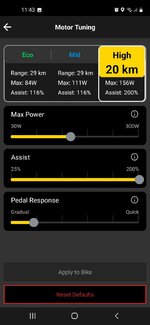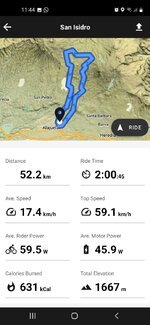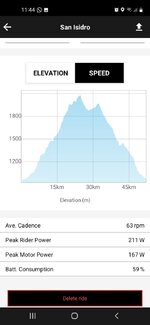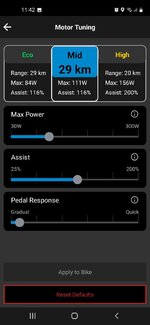AntonioAlfaro
Active Member
- Region
- Other
Allow me to share data from my first ride in Domane+ SLR6. For many years I have used the Orbea Gain D50 which is a first generation ebike based on the Mahle X35, today I have been really impressed with the performance and comfort of the Domane+.
Prior to this first outing, I used a Wahoo Smart trainer to simulate different slopes and after multiple adjustments I was ready to hit the streets.
The assist settings are based on my 140W FTP and the different assist ranges are based on % slopes.
Prior to this first outing, I used a Wahoo Smart trainer to simulate different slopes and after multiple adjustments I was ready to hit the streets.
The assist settings are based on my 140W FTP and the different assist ranges are based on % slopes.
Attachments
-
 Screenshot_20230716-114301_Trek Central.jpg80.1 KB · Views: 313
Screenshot_20230716-114301_Trek Central.jpg80.1 KB · Views: 313 -
 Screenshot_20230716-114426_Trek Central.jpg125.8 KB · Views: 313
Screenshot_20230716-114426_Trek Central.jpg125.8 KB · Views: 313 -
 Screenshot_20230716-114418_Trek Central.jpg67.5 KB · Views: 286
Screenshot_20230716-114418_Trek Central.jpg67.5 KB · Views: 286 -
 Screenshot_20230716-114256_Trek Central(1).jpg79 KB · Views: 303
Screenshot_20230716-114256_Trek Central(1).jpg79 KB · Views: 303 -
 Screenshot_20230716-114246_Trek Central.jpg77.6 KB · Views: 320
Screenshot_20230716-114246_Trek Central.jpg77.6 KB · Views: 320
